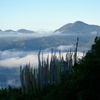WRITINGS |
|
Bhutan - Impressions |
|
Arriving in Bhutan is a surreal experience. First, it's almost surprising that you arrive at all, given the way the small DrukAir plane dips and dances among the high ridges - much like the huge Himalayan Griffon Vultures which glide on mountain thermals - then plunges into low valleys until the right one is found (the Paro Valley), which is just wide enough and long enough for a "safe" landing. Then, as you step down onto the tarmac you are confronted by the crackling clarity of the light and air in front of the most ornate and colourful airport in the world, built in the traditional Bhutanese architectural style.
Along with the clear freshness of the air at this altitude (2300 metres/7,545 feet) you are struck, rather breathtakingly, by the sheer vastness of the land. Countless mountain ranges of the Himalayas peak and fold, rising dizzyingly into an expansive sky, running far northward to the forbidding Tibetan Plateau, and into the west where the Annapurna Range boasts the highest mountains in the world. You are in a place where you are often looking down at the clouds rather than up at them. This feeling of vastness has another connotation as well, implying the depth and agelessness of a distinctive and ancient culture which has endured and is continuing to flourish in a small kingdom on the "roof of the world".
As I write this, it is mid-January. The rainy season is long over, and most of Bhutan is desert-dry. The harvest is in. The crazy-quilt-like rice fields present a rich array of textures in faded siennas and greys. Some have already been ploughed over; others feature harvest stubble; others still have small, neatly ordered stacks of bleached straw. Bhutan's ancient culture thrives on a seasonal cycle of rice and religious festivals (tsechus) which are interwoven in rich and colourful traditions that blend the religious and secular in unique harmony. There is a timelessness in Bhutan which reaches deep into the past and far into the future. Space and time seem mysteriously altered and irrevocably changed.You begin to adjust to this shift when you encounter the colours that the Bhutanese have grafted onto their harsh environment. Everywhere there is evidence of meaningful human intervention in the landscape through an intentional use of colour. Lungta (prayer flags) flutter in riotous colours along ridge tops and rivers in the ever-present winds. And almost every building, from the most modest homes to the dominating tsongs (massive palaces housing monasteries and seats of government), features intricate and highly ornate pattern). This decorative style is exclusively Bhutanese in its sophistication and complexity, and features many layers of decorative and repetitive mantra-like patterns (Image 5). It is as if the hand and mind, not satisfied with just one line or pattern, has returned to it again and again, adding to its richness and variation much like a Bach fugue. Likewise, the distinctive indigenous weaving style of Bhutan's renowned textiles reflects the weaver's technical ingenuity and artistic diversity in a dedication to detail, colour, and to the language of pattern and shape.
(excerpt from Bhutan - Impressions by Andrea Maguire)
For the full articles on Bhutan go to: Bhutan – Impressions, First instalment, March 2008Bhutan – Impressions, Second instalment, April 2008 Bhutan – At the Crossroads, Third instalment, 2008
|
||
All text and images © Andrea Maguire |
||
